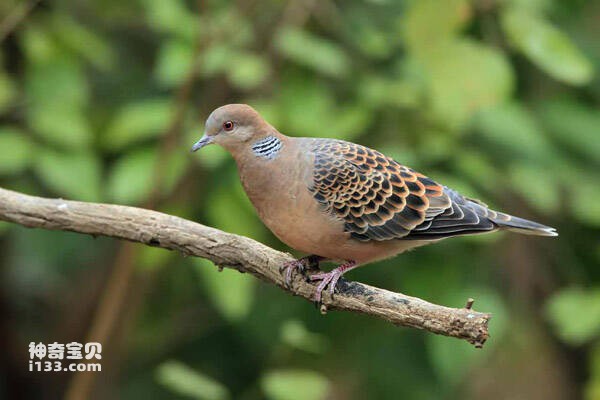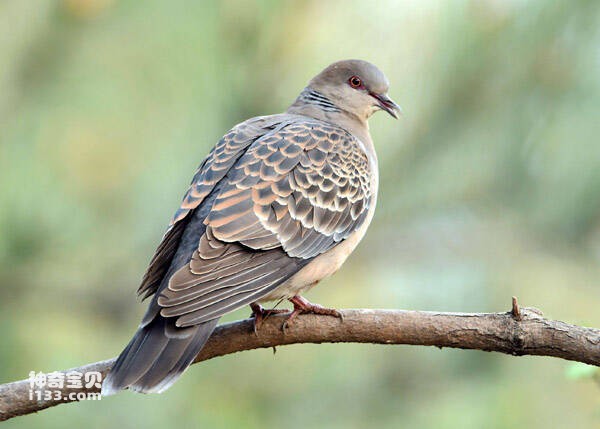Streptopelia orientalis
IUCN
LCBasic Information
Scientific classification
- name:Streptopelia orientalis
- Scientific Name:Streptopelia orientalis, Oriental Turtle-dove, Golden back turtle, Monoceros dove, pheasant dove, Monoceros, Flower wing, Streptopelia orientalis, Oriental Turtle-dove
- Outline:Landfowl
- Family:
Vital signs
- length:26-35.9CM
- Weight:175-323g
- lifetime:No textual research information is available
Feature
On both sides of the neck base, there is a black plume with blue-gray margin, forming a prominent black-gray neck spot
Distribution and Habitat
World distribution: Afghanistan, Bangladesh, Bhutan, Cambodia, India, Iran, Islamic Republic of China, Japan, Kazakhstan, Korea, North Korea, Kyrgyzstan, Lao People's Democratic Republic, Mongolia, Myanmar, Nepal, Pakistan, Russian Federation, Tajikistan, Thailand, Turkmenistan, Uzbekistan, Viet Nam.
Travellers: Austria, Canada, Denmark, Egypt, Finland, France, Germany, Greece, Iraq, Israel, Italy, Kuwait, Maldives, Norway, Portugal, Russian Federation, Saudi Arabia, Sri Lanka, Sweden, United Arab Emirates, United Kingdom, United States.
Origin uncertain: Oman.
Distribution in China: Distribution from Heilongjiang in the north, south to Hainan Island, Hong Kong and Taiwan, west to Xinjiang, Tibet, throughout the country.
It lives in low hills, plain and mountain broad-leaved forests, mixed forests, secondary forests, orchards and farmland, and bamboo forests and trees near houses.
Appearance
The male and female of the mountain dove are similar. The forehead and the front of the head are blue-gray, the back of the head to the back of the neck is brownish gray, and there is a black feather with blue-gray margin on each side of the neck base, forming a prominent black-gray neck spot. Upper dorsal brown, each feather margin is reddish-brown; The lower back and waist are bluish-gray, the upper tail cover and tail are both brown, with bluish-gray feathers, and the bluish-gray feathers are wider to the outer side. The outermost tail feathers are grayish white. Shoulder and inner feathers dark brown, with reddish-brown feather margin; Outer middle cover and large cover deep SLATE gray, the tip of the feather is light; The feathers are dark brown with a light margin. The lower body is reddish brown wine, chin and throat brown with pink, chest with gray, abdomen light gray, two flanks, fu-feathers and tail undercover blue gray. The irises are golden or orange, the mouth is lead-blue
Details
The scientific name Streptopelia orientalis, the foreign name Oriental Turtle-dove, has 6 subspecies.

Mountain turtle doves often live in pairs or small groups, sometimes in pairs to perch on trees, or in pairs to fly and feed together. If the female bird is injured, the male bird flies back to the original place after several degrees of circling. It is very active when moving on the ground, often moving quickly in small steps, searching for food while walking, and swinging its head back and forth. The wings flutter frequently in flight, straight and fast. Sometimes they also glide, especially when flying from trees to the ground. The hum is low, and its sound is repeated many times like 'ku-ku-ku'.
Mountain turtle doves mainly eat a variety of plant fruits, seeds, grass seeds, young leaves, buds, but also eat crops, such as rice, corn, sorghum, millet, beans, mung beans, rapeseed, young snails, and sometimes eat lepidoptera larvae, beetles and other insects. Foraging is mostly in the understory, forest edge and farmland. In winter, the camphor seed core spit out by blackbird after eating camphor seed becomes an important food source for mountain turtle dove.

The breeding time of the mountain turtle dove is from April to July. The average annual production is 2 broods, usually in pairs when migrating. Nest in the trees in the forest, but also in the bamboo forest, lonely trees or bushes next to the house. The nest is usually placed on the trunk of the branch, above the ground height of 1.5-8 meters. The nest is very simple, mainly composed of dead thin branches interleaved and stacked, the structure is very loose, from below you can see the eggs or chicks in the nest. The size of the nest is 14-18 cm ×16-20 cm in outer diameter, 8-10 cm ×8-11 cm in inner diameter, 4-8 cm in height, and 3-5 cm in depth. The nest has no inner padding, or only a few leaves, moss and feathers. The eggs are white, oval, smooth and unspotted, 28-37 mm ×21-27 mm in size and 7-12 g in weight. Male and female birds incubate eggs in turn, during the incubation period is very love nest, sometimes people walk or stay under the nest and fly away from the nest, incubation period 18-19 days. The chicks are late sex, and when they emerge from their shells, they are bare and featherless, with only a few sparse yellow hair-like feathers on their bodies. Raised by both male and female parent birds, the chicks put their beak into the mouth of the parent bird to eat the semi-digested milk food "pigeon milk" from the parent bird. After 18 to 20 days of feeding, the young bird can leave the nest and fly.
Listed on the International Union for Conservation of Nature (IUCN) 2012 Red List of Threatened Species ver 3.1 - Not Threatened (LC).
It was included in the List of Beneficial Terrestrial Wildlife under State Protection or of Important economic and scientific research Value issued by the State Forestry Administration of China on August 1, 2000.
Protect wild animals and eliminate wild meat.
Maintaining ecological balance is everyone's responsibility!








